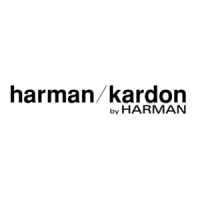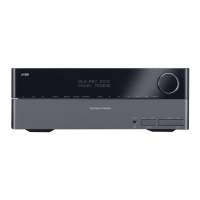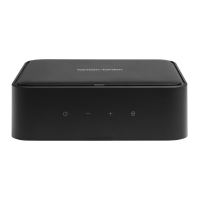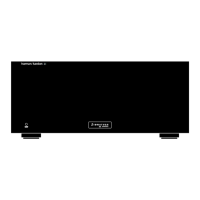Citation 7.0 Owner’s Manual
Preliminary Draft
Page # 9
Enitre Contents Copyright ©1995 - Harman Kardon Inc.
Citation 7.0 Owners Manual
Surround Modes Description
Surround Modes
Surround sound, or multi-channel audio, is the process of reproducing sound through more than two speakers in a
listening environment. In some cases the positioning of the sounds in particular locations is set by the sound mixer
when the recording is made. This is the case with program materials encoded with the Dolby Surround Matrix, such as
most pre-recorded movies, many television programs and a growing number of audio CD.
While many of the programs you listen to through the Citation 7.0 are surround encoded, many, such as the vast
majority of two channel recordings do not have intentional surround cue information. However, most stereo recordings
do capture ambient sound information during the recording process. By careful processing of the two channel
information, it is possible to create a variety of sonic presentation using center and rear channels, in addition to the
front left and right “stereo” speakers. This is called multi channel sound.
In addition to creating surround from encoded sources, the 7.0 is equipped with specialized circuits that use Jim
Fosgate’s exclusive designs to create enveloping, multi channel sound fields from almost any conventional two
channel stereo or monophonic recording. Unlike conventional surround processors, Digital Signal Processing (DSP) is
only used to create delays and timing for the rear channels. While the control over the signals is done by a digital
microprocessor, the front channel audio signals remain in the analog domain for pure signal transmission. This
assures that no unwanted artifacts are added to a recording or sound track.
It is worth noting that over sixty years ago, when the earliest experiments into sound recording and reproduction were
conducted, it was determined by the scientists at Bell Laboratories that the preferred way to listen to prerecorded
sound was to use at least three speakers in the front of a listening room, and at least two in the rear. Unfortunately, the
limitations of recording technology have confined us to two channels for many years. This notion of “stereo” meaning
left and right channels only is a misnomer.
True
stereo sound is actually multi channel audio, and that is what the Citation 7.0 has been designed to deliver from
any source material, be it encoded, encoded or even single channel mono. It does not matter if the playback source is
a laser disc, CD, audio cassette, FM tuner, TV or satellite broadcast, cable program or even an old vinyl record. The
key is to be able to accurately place sound information in the correct speaker location so that a pleasing presentation
is created.
If there was a means of placing sounds in specific locations, using separate discrete channels, there would probably
be no need for a variety of surround modes. That is exactly what the new digital multi-channel audio systems such as
Dolby Digital Stereo, also known as AC-3, and the competing system from DTS do. Unfortunately, there is an
extremely limited amount of this type of software available. For the foreseeable future, 99% of the recordings and
movies available will require the use of surround processing to extract the different channels and determine where
they should be placed.
Given the limitations of the surround process, a listener needs to have some control over where the sounds appear in
a room. In addition, individual listener preferences will influence where you want the sounds to appear in your room.
For this reason, the Citation 7.0 offers a wide variety of surround modes. The factory preset modes include Dolby
ProLogic and Home THX, as well as a variety of Jim Fosgate designed modes that are customer tailored to position
sounds in a specific manner. Based on over twenty years of research in surround sound technology and psycho-
acoustic design, they are the most advanced surround modes available.
These surround modes are a combination of the various parameters that are controlled in the 7.0. Since many of these
parameters are also user controllable, the 7.0 is unique in that it allows you to experiment and create your own sound
modes. The 7.0 may hold up to four user configured modes.

